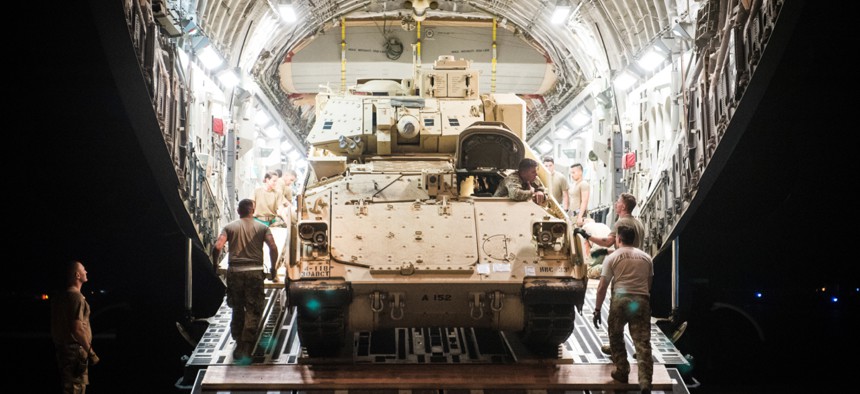
An M2 Bradley Fighting Vehicle is loaded onto a U.S. Air Force C-17 Globemaster III at Ali Al Salem Air Base, Kuwait, Oct. 30, 2019. Capt. Thomas Barger
U.S. Army Cancels $45B Armored Vehicle Contest That Drew One Bid
The service now plans to reboot its effort to replace the Bradley Fighting Vehicle, but with different bidding parameters.
The U.S. Army said it would reevaluate its effort to replace the Bradley Fighting Vehicle after just one company submitted a qualifying bid in the $45-billion contest.
“Based on feedback and proposals received from industry, the Army has determined it is necessary to revisit the requirements, acquisition strategy and schedule before moving forward,” the Army said in a statement released Thursday afternoon.
The statement did not mention that only General Dynamics submitted an eligible bid. The Army disqualified a Raytheon-Rheinmetall team because it was unable to get its German-made Lynx fighting vehicle to the United States by Oct. 1. SAIC and Bradley-maker BAE Systems did not submit bids.
Thursday’s decision is a setback for Army Futures Command, founded in 2018 to lead the modernization of the service’s weapons. But the Army did live up to Secretary Ryan McCarthy’s edict: “If you fail, we'd like you to fail early and fail cheap."
After several failed attempts to buy new combat vehicles, the Army tried to fast-track the Bradley replacement, which it calls the Optionally Manned Fighting Vehicle. But the speed helped contribute to its demise.
"The Army asked for a great deal of capability on a very aggressive schedule," Bruce Jette, assistant Army secretary for acquisition, logistics, and technology, said in a statement. "Despite an unprecedented number of industry days and engagements, to include a draft request for proposal over the course of nearly two years — all of which allowed industry to help shape this competition — it is clear a combination of requirements and schedule overwhelmed industry's ability to respond within the Army's timeline."
The Optionally Manned Fighting Vehicle was to replace the M-2 Bradley, a tracked armored vehicle that carries infantry soldiers into combat, with a more modern vehicle that could be driven remotely. Replacing the Bradley is still the Army’s No. 2 acquisition priority and Army leaders are hoping to have more bidders the next time around.
"We are going to take what we have learned and apply it to the [Optionally Manned Fighting Vehicle] program to develop our path and build a healthy level of competition back into the program,” Gen. John Murray, the head of ArmyFutures Command, said in a statement.
BAE Systems, which did not submit a bid, said in an emailed statement that it “is dedicated to providing combat vehicle solutions to meet the needs of the U.S. Army’s modernization efforts. When the Army releases the new [Optionally Manned Fighting Vehicle] approach, we look forward to evaluating it and making a determination about how BAE Systems can best continue our commitment to the warfighter and the Army.”
A General Dynamics spokesman declined to comment. Raytheon-Rheinmetall and SAIC were not immediately available for comment.
McCarthy acknowledged at the at the Reagan National Defense Forum in December that officials were reviewing the Bradley replacement effort.
“You always want more competition, but this is entirely about how we can meet these requirements so we can have a capability that has much greater lethality … than we have today,” he said. “Requirements are incredibly important. We’ve made dramatic steps as an organization to put the strong leadership in our requirements community and to partner with our acquisition leadership.
“Getting requirements right on the front-end prevents you from the catastrophic failures that we’ve endured for the past 20 years,” McCarthy said.







